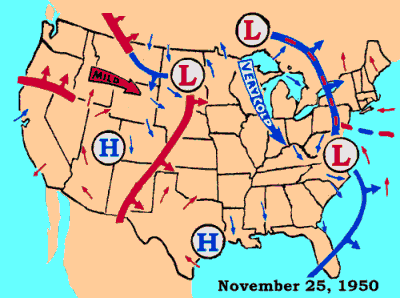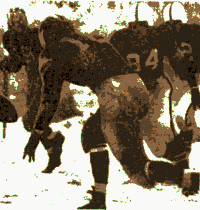 |
 |
| Home | Welcome | What's New | Site Map | Glossary | Weather Doctor Amazon Store | Book Store | Accolades | Email Us |
 | |||||||||
Weather Almanac for November 2000SPORTING WEATHERDuring the final days of the recent Sydney Olympics, competitors in the canoeing and kayaking finals faced an additional challenge: the weather, more specifically, the wind which raised whitecaps on the course. And yet, days before, the sailing competition was hindered by a lack of wind. Earlier in the Sydney Games, rain during the men's high jump final likely influenced the outcome as jumpers contended with a slippery runway. Some have argued that competing under adverse weather conditions is unfair to the competitors. But, is this not one of the reasons for still holding events outdoors? All but a few sports could be contested indoors, but by competing outdoors, the weather adds that unknown factor that makes sports such fun to watch and an increased challenge for participants. Weather has definitely played a role in many athletic competitions in which I have been involved. Many times I have taken the field for a slo-pitch softball game where heat, cold, rain, wind, or snow (yes once) was a factor. Sometimes the weather made the game more challenging: try pitching a softball with a high-arc during a strong crosswind, or hitting such a pitch. And sometimes, it was just plain miserable. While all outdoor sports can be influenced by weather, indoor events can as well. I recall that only one baseball game at the Houston Astrodome was ever "rained out." Impossible, you say? But true. The reason: flooding of the streets of Houston prevented the teams and fans from traveling to the ballpark. I write about weather and sports in November because I have many vivid memories from this month of weather's role in my enjoyment of sports as a spectator/fan. One of my all-time favourite sports pictures -- I had it on my bulletin board for most of my teen years -- accompanied a Sports Illustrated account of an Ivy League football game in the 1960s. The picture focused on the Princeton placekicker attempting a field goal through a swirling snowstorm. I do not recall if the kick successfully split the up-rights, but the photo ingrained an image on my memory, a surreal focus on the players and the ball engendered by the surrounding snowflakes, that still remains vivid.
One of the most famous Grey Cup games is remembered perhaps not for the action on the field but for the role of the weather in the game. This game between Hamilton and Winnipeg was played along Toronto's lakeshore beginning on December 1, 1962. I say beginning because the game was completed the following day. During the final quarter of play, a heavy, dense fog descended on the field of play. Visibility was reduced to feet, preventing fans from seeing the action. Officials and players could not see the field markers nor each other except when close together. Officials were forced to stop the game and resume it when conditions improved the next day. Bud Grant's Winnipeg Blue Bombers finally won the two-day Fog Bowl by a score of 28-27. The 1950 Blizzard Bowl: Michigan-Ohio State ClassicOne football game in which weather played a major role -- not only on the field but in the community -- was the infamous Blizzard Bowl contest between my alma mater, the University of Michigan, and Ohio State on November 25, 1950, fifty years ago this month. The story begins late on November 23th, Thanksgiving Day, as a cold front sweeps southeastward across Ohio. The storm to which the front is associated then stalls north of Lake Superior funneling arctic air over the State. Rain turns first to sleet and then to snow as the temperature plunged to deep winter levels. Friday morning dawned with temperatures across Ohio around 30 Fo (16.7 Co) colder than the previous day's high. In Columbus, Ohio, where the traditional rivalry between the Michigan Wolverines and Ohio State Buckeyes was to be played on Saturday, the low temperature fell to a frigid 5 oF (-15 oC). Intermittent snowfall continued all day Friday in Columbus. The forecast temperature for game time Saturday was 15 oF (-9 oC) with gale-force winds pushing the windchill to extreme levels. But the forecast did not account for the influence of a second storm center located off the Carolina coast. This system began pumping moisture like a fire hose into the cold air over Ohio and western Pennsylvania. 
By the time the sun rose Saturday, the region resembled the Arctic. Pittsburgh, Pennsylvania was buried under 16 inches (40 cm) of white with another foot (30 cm) forecast for the next 24 hours. Northern Ohio lay under 18 inches (46 cm) with drifts over 6 feet (1.8 m) high. Southern Ohio reported 14 inches (36 cm) on the ground and gale winds. Winds on Lake Erie howled at over 50 mph (80 km/h). Steubenville, Ohio reported 25-foot (7.6 m) drifts. Transportation ground to a halt all across Ohio. A few trains bringing fans and the Michigan team pushed into Columbus, much delayed. Road traffic was at a stand-still. Thousands of cars lay stranded across central Ohio; many headed for the game. One witness, remembering the trials of the Great Arctic explorers, remarked: "Only Peary, Cook, and Amundsen could get through to this game!" Should the game be played? Although over 82,000 tickets had been sold, Ohio State ticket director J. Edward Weaver was pessimistic. "We couldn't expect more than half of them to be here. I'll be surprised if anybody comes except the players' families and friends." The coaches and athletic directors from the two schools conferred and finally announced: "The game is on! We'll just have to do the best we can." At the stadium, the hardy souls who would attend the game began arriving. Wrapped in an odd assortment of blankets and other gear, the crowd plodded toward the stadium and their snow- covered seats like a line of refugees. Some sat huddled in the stands with cardboard cartons over their heads, cartons with peepholes cut for vision. Many tried to build fires under the stands. Stadium officials warned that all toilets in the top of the stadium were frozen. At 2 PM, the Ohio State marching band, added by antifreeze in their horn valves, struck up the Buckeye Battle Cry. As a gusty 28-mph (45 km/h) wind whipped snow around the horseshoe-shaped stadium, 50,503 brave, or insane, fans cheered as the teams lined up for Ohio State's opening kickoff. It sailed into the swirling 10 oF (-12 oC) air and was downed on the Michigan 28-yard line. The Wolverines set the tenor of the game by immediately punting the ball back to the Buckeyes. Ohio State tried a few running plays but the poor footing stopped them. They kicked back to Michigan who immediately went back into punt formation. Punter Chuck Ortmann's kick, however, was blocked, and Ohio State recovered on the Michigan 6-yard line. (For a more complete account of the game, go to Michigan vs Ohio State: The 1950 Blizzard Bowl.) 
The Buckeyes tried a few passes, but only one was successful. A lull in the wind gave OSU star Vic Janowicz a vision: In the huddle, he told his team: "I can see the goal posts. Let's try a field goal." The kick was good and Ohio State led 3-0. For the rest of the first half, the teams continued to trade punts, hoping to force a mistake on their opponents. The first came when Michigan successfully blocked a Buckeye punt back through the end zone for a safety. The score was now 3-2 for Ohio State. Late in the half, Michigan again blocked an OSU punt into the end zone. Players from both teams dove through the snowdrifts in search of the elusive pigskin. Michigan was the winner of the quest and awarded the touchdown. With the extra point, the Wolverines lead 9-3, as the first half ended. Although Ohio State changed from cleats to tennis shoes in hopes of getting better traction, it was to no avail. During the second half, the blowing snow was so heavy, visibility was near zero. The second half action was again dominated by the punters, hoping just to keep their teams out of trouble and perhaps force a mistake by their opponents. No further points were scored, and Michigan, with the 9-3 victory, earned at trip to much warmer Pasadena for the Rose Bowl for their frigid efforts. While the game was over, the real contest began: the fans against the weather. The goal: getting home. Most of the autos in the parking lot were buried beneath snow drifts. Roads were clogged with snow and with abandoned vehicles. Public transportation was not moving. At the Oakland Hotel in nearby Marysville, all rooms were full, and 100 stranded travelers slept in the lobby. Fears gnawed at stadium groundskeeper Ralph Guarasci through the night as he and his crew searched rolled up sections of tarp, restrooms and passageways in the huge stadium for fans who may have passed out from excess "frostbite serum" and might now be freezing to death. Fortunately, none were found.
The eastern half of Ohio reported total storm snowfalls of over 20 inches (51 cm). Western Ohio was "lucky," only receiving 10-20 inches (25 to 51 cm). Steubenville accumulated 36.3 inches (92 cm) over the three days. Should the game have been played? One Ohio undergraduate answered the reporter's question through snow-encrusted eyelashes: "Certainly the game should have been played. It's part of the American tradition and should be played, snow or no snow, cold or no cold." Written by
|
|||||||||
 |
To Purchase Notecard, |
Now Available! Order Today! | |
 |
 |
NEW! Now |
The BC Weather Book: |


